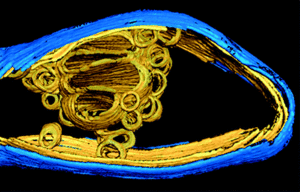Blastochloris: Difference between revisions
| Line 15: | Line 15: | ||
==Structure, Metabolism, and Life Cycle== | ==Structure, Metabolism, and Life Cycle== | ||
''Blastochloris viridis'' is gram-negative, and therefore does not contain a thick wall of peptidoglycan. It has two outermembranes, one composed of a thin layer of peptidoglycan and the other of polysaccharides. The organism is a faculative anaerobe. In the presence of oxygen it acts as a heterotroph, obtaining carbon sources from other life forms around it. In anaerobic conditions, it becomes a photoheterotroph, obtaining energy from light and processing it through reaction centers within the membranes in order to form carbon. | |||
Interesting features of its structure; how it gains energy (how it replicates, if virus); what important molecules it produces (if any), does it have an interesting life cycle? | Interesting features of its structure; how it gains energy (how it replicates, if virus); what important molecules it produces (if any), does it have an interesting life cycle? | ||
Revision as of 20:04, 22 July 2013
Classification
Bacteria; Proteobacteria; Alphaproteobacteria; Rhizobiales; Hyphomicrobiaceae; Blastochloris
Genus Species
Blastochloris viridis
Description and Significance
Blastochloris virdis is a purple non-sulfur beta proteobacteria. The proteobacteria are a large, metabolically diverse bacterial phyla consisting of gram-negative organisms. [3] It is both a heterotroph and a photoheterotroph. It absorbs light around the wavelength of 400 nm and 1,000nm, resulting in its purple color. It has one of the simplest photosynthetic systems, composed of just one light-harvesting complex surrounding the reaction center. [2] The light-harvesting complex is photosytem II. [3] Its simplicity has lead to its usage in the study of plant biochemistry and pathways. One landmark study in 1989 regarding the structure of the light-harvesting complexes feautured Blastochloris viridis and has since contributed to a general understanding of the reaction center's present in all oxygenic phototrophs, as well as how they acclimate to alterations in light intensity and quality. [4]
Structure, Metabolism, and Life Cycle
Blastochloris viridis is gram-negative, and therefore does not contain a thick wall of peptidoglycan. It has two outermembranes, one composed of a thin layer of peptidoglycan and the other of polysaccharides. The organism is a faculative anaerobe. In the presence of oxygen it acts as a heterotroph, obtaining carbon sources from other life forms around it. In anaerobic conditions, it becomes a photoheterotroph, obtaining energy from light and processing it through reaction centers within the membranes in order to form carbon.
Interesting features of its structure; how it gains energy (how it replicates, if virus); what important molecules it produces (if any), does it have an interesting life cycle?
Ecology and Pathogenesis
Natural habitat (soil, water, commensal of humans or animals?)
If relevant, how does this organism cause disease? Human, animal, or plant hosts? Important virulence factors, as well as patient symptoms.
References
[1] http://www.ncbi.nlm.nih.gov/Taxonomy/ [2] Photosynthetic System in Blastochloris viridis Revisited Marina Konorty, Vlad Brumfeld, Andre Vermeglio, Nava Kahana, Ohad Medalia, and Abraham Minsky Biochemistry 2009 48 (22), 4753-4761 [3] [4]Niederman, Robert A. "Membrane development in purple photosynthetic bacteria in response to alterations in light intensity and oxygen tension." Photosynthesis research (2013)
Author
Page authored by Samantha Landvick, student of Mandy Brosnahan, Instructor at the University of Minnesota-Twin Cities, MICB 3301/3303: Biology of Microorganisms.

